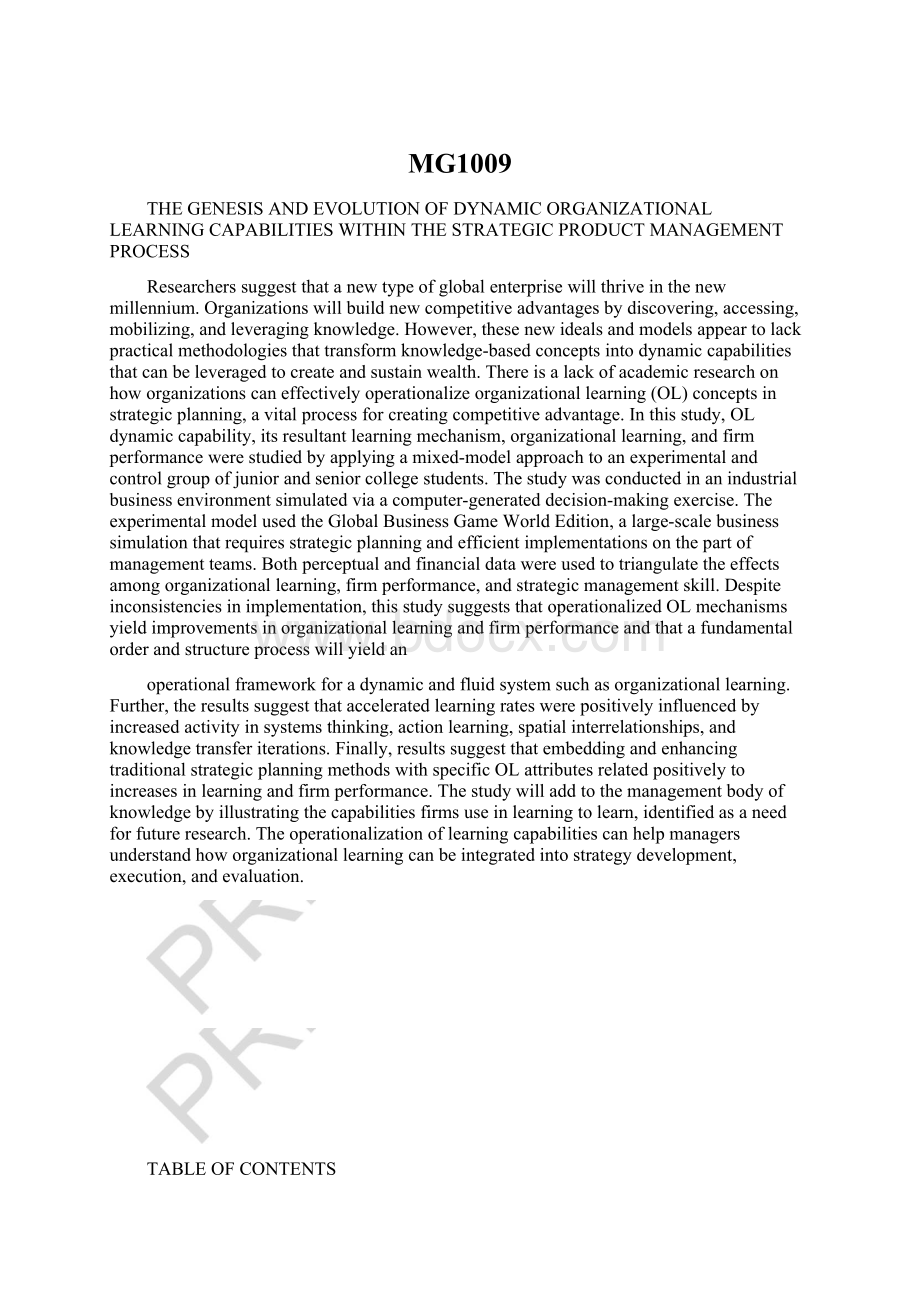MG1009.docx
《MG1009.docx》由会员分享,可在线阅读,更多相关《MG1009.docx(10页珍藏版)》请在冰豆网上搜索。

MG1009
THEGENESISANDEVOLUTIONOFDYNAMICORGANIZATIONALLEARNINGCAPABILITIESWITHINTHESTRATEGICPRODUCTMANAGEMENTPROCESS
Researcherssuggestthatanewtypeofglobalenterprisewillthriveinthenewmillennium.Organizationswillbuildnewcompetitiveadvantagesbydiscovering,accessing,mobilizing,andleveragingknowledge.However,thesenewidealsandmodelsappeartolackpracticalmethodologiesthattransformknowledge-basedconceptsintodynamiccapabilitiesthatcanbeleveragedtocreateandsustainwealth.Thereisalackofacademicresearchonhoworganizationscaneffectivelyoperationalizeorganizationallearning(OL)conceptsinstrategicplanning,avitalprocessforcreatingcompetitiveadvantage.Inthisstudy,OLdynamiccapability,itsresultantlearningmechanism,organizationallearning,andfirmperformancewerestudiedbyapplyingamixed-modelapproachtoanexperimentalandcontrolgroupofjuniorandseniorcollegestudents.Thestudywasconductedinanindustrialbusinessenvironmentsimulatedviaacomputer-generateddecision-makingexercise.TheexperimentalmodelusedtheGlobalBusinessGameWorldEdition,alarge-scalebusinesssimulationthatrequiresstrategicplanningandefficientimplementationsonthepartofmanagementteams.Bothperceptualandfinancialdatawereusedtotriangulatetheeffectsamongorganizationallearning,firmperformance,andstrategicmanagementskill.Despiteinconsistenciesinimplementation,thisstudysuggeststhatoperationalizedOLmechanismsyieldimprovementsinorganizationallearningandfirmperformanceandthatafundamentalorderandstructureprocesswillyieldan
operationalframeworkforadynamicandfluidsystemsuchasorganizationallearning.Further,theresultssuggestthatacceleratedlearningrateswerepositivelyinfluencedbyincreasedactivityinsystemsthinking,actionlearning,spatialinterrelationships,andknowledgetransferiterations.Finally,resultssuggestthatembeddingandenhancingtraditionalstrategicplanningmethodswithspecificOLattributesrelatedpositivelytoincreasesinlearningandfirmperformance.Thestudywilladdtothemanagementbodyofknowledgebyillustratingthecapabilitiesfirmsuseinlearningtolearn,identifiedasaneedforfutureresearch.Theoperationalizationoflearningcapabilitiescanhelpmanagersunderstandhoworganizationallearningcanbeintegratedintostrategydevelopment,execution,andevaluation.
TABLEOFCONTENTS
Acknowledgementsii
ListofTablesvii
ListofFiguresviii
CHAPTERONEINTRODUCTIONANDSTATEMENTOFTHEPROBLEM1
StatementoftheProblem3
BackgroundoftheProblem3
PurposeoftheStudy5
TheorecticalSupportfortheStudy7
Assumptions^...^^..^Ir.9
ScopeandDelimitations.^.^^^JL10
Limitations11
NatureoftheStudy^.....^^...^W..12
DefinitionofTerms14
HypothesisandReseahQuestions16
SignificanceoftheStudy22
SummaryandOverview23
CHAPTERTWOLITERATUREREVIEW25
Introduction25
EarlyHistoryofOrganizationalLearning27
ShiftfromTangibletoIntangibleAssetsinCompetitiveAdvantage29
TransitionandEvolutionofOrganizationalLearning31
AlternativesandObjectionstoConventionalOLTheory37
TheoreticalBasisofModel39
OLDynamicCapabilityProcessOverview42
CodifyingContemporaryOLTheory48
Hypothesizedrelationships52
ProductPortfolioAnalysis:
TheValueT52
ResearchMethodology57
CHAPTERTHREEMETHODOLOGY60
Introductioni^r....'k..../^*60
DescriptionofResearchDesign61
InternalandExternalValidity68
Reliability.^fT...^..^T71
Targetpopulation.^^^..^^.^fT73
Treatment^^^%^^A^Tn74
Instrumentation76
DatacollectionProcedures79
DataAnalysisProcedures79
PilotStudyFindings82
RoleofResearcher85
ProtectionofHumanParticipants86
Summary87
CHAPTERFOURRESULTS89
Introduction89
InconsistenciesinResearchMethodology90
EmphasisonQualitativeAnalysis93
ScreeningofDataandValidation94
QualitativeFindings96
TriangulationandConvergenceofFindings109
Summary111
CHAPTERFIVECONCLUSIONSANDRECOMMENDATIONS112
SummaryofStudy^T....^>....„^&113
ResearchQuestions114
EmergingandAlternativeExplanations119
ImplicationsforManagment120
ImplicationsforFutureTheoryDevelopment122
ImplicationsforFutureEmpiricalResearch124
Summary125
REFERENCES127
APPENDICES
AppendixASurveyInstruments137
AppendixBOLAssessmentMatrix141
AppendixCStrategicPlanningTreatmentforControlandExperimentalGroups142
AppendixDBusinessSimulationComparisonMatrix152
AppendixEOLDynamicCapabilityProcessandDevelopmentofValueT153
AppendixFHowtoUseValueTDetail158
AppendixGLettertoParticpant171
AppendixHInformedConsentFormi^r....'k..../^*172
AppendixILetterofApprovaltoConductResearch174
AppendixJTeamActivityReport175
LISTOFTABLES
Table1:
StrategicPlanningDeficiencies51
Table2:
DemographicComparisonBetweenGroups96
Table3:
QualitativeFindingsRubric101
Table4:
EndofSimulationOLAttitudinalResults105
Table5:
EndofSimulationFirmPerformance107
Table6:
AttitudinalStrategicScores108
A^W^^.f
LISTOFFIGURES
Figure1:
ProposedTheoreticalModel5
Figure2:
OLDynamicCapabilityProcess17
Figure3:
IntegrationofKeyTheoreticalConcepts44
Figure4:
InterrelationshipDiagram47
Figure5:
TheValueTDiagram54
Figure6:
BehavioralTheoryRepresentation55
Figure7:
SingleandDoubleLoopDemonstratedm^^dvw55
Figure8:
VisualTheoryRelationship56
Figure9:
UnificationTheory56
Figure10:
StudyGroupSegmentation65
Figure11:
EqulibrationPeriod66
Figure12:
KeyStudyMilestonesandLogistics78
Figure13:
ResearchDesignandTimeline88
Figure14:
ActualResearchMethodology90
Figure15:
GraphofUnificationResponsesBetweenGroups97
Figure16:
GraphofKnowledgeTransferBetweenGroups98
Figure17:
GraphofSingleandDoubleLoopLearningBetweenGroups99
Figure18:
GraphofCognitiveLearningResponsesBetweenGroups99
Figure19:
GraphofBehavioralLearningResponsesBetweenGroups100
Figure20:
PerformanceIndexbyGroups106
Figure21:
StrategicSkillsMeanRankingsbyConstruct108
CHAPTERONEINTRODUCTIONANDSTATEMENTOFTHEPROBLEM
Accordingtoresearch,anewtypeofglobalenterprisewillthriveinthenewmillennium.Thesecorporationswillbuildnewcompetitiveadvantagesbydiscovering,accessing,mobilizing,andleveragingknowledge.Thisnewcorporationwillachieveandsustaincompetitiveadvantagebydevelopingvaluechainswithdistinctcorecompetencies;innovatingthroughtechnologicaladvances;quicklytappingemergingmarketsegmentsaroundtheworld;leveragingknowledgescatteredthroughoutitssubsidiaries;andmobilizingthisfragmentedknowledgetogenerateinnovationsthatproduce,market,anddelivervalueonaglobalscale(Ricart,Enright,Hart,&Kanna,2004).Bythecloseofthe20thcentury,compelitiTeadvantageshiftedfromprimarilytangibleresourcestoknowledge-basedstrategiesthatdeployorganizationalintangibleresourcessuchasorganizationallearning,innovation,andcustomerrelationshipsthat,inturn,fuelfirmperformance(Rutterford,Upton,&Kodwani,2006).Thisshiftincompetitiveadvantageisbeingdrivenbycontinualtechnoloacala*vancementsandthedemandsofaglobaleconomy.
Researchemergedinthelatterpartofthelastcenturythatofferspotentialbreakthroughideasformovingorganizationstonewlevelsofperformanceintheknowledgeage(Argyris,1977;Nonaka,1995;Senge,2004;Zollo&Winter2002).However,thesenewmodelslackpracticalmethodologiesandcapabilitiesthattransformtheseknowledge-basedconceptsintodynamiccapabilities.Thesedynamiccapabilitiesarelearnedandstablepatternsofcollectiveactivitythroughwhichtheorganizationsystematicallygeneratesandmodifiesitsoperatingroutinesinpursuitofimprovedeffectiveness(Zollo&Winter,2002).Thisexploratorystudy
examinedthisknowledgegapandpresentsanorganizationallearning-baseddynamiccapabilitythatsystematicallycreatesorevolvesoperatingroutinesthatincorporatecriticalOLattributes.Theseroutinesenhanceunderstandingofthecasuallinkagesorinterrelationshipsbetweentheactionsorganizationstakeandtheperformanceoutcomestheyobtain.
ThisresearcherintroducedanOL-baseddynamiccapabilityfoundedonrecentadvancementsinknowledgetransformationandchaostheoryandappliedittocontemporarystrategicplanningmethodologiestoimproveorganizationallearningandvaluecreation.Researchinorganizationallearninganditsapplicationtostrategicplanningrevealsconceptualmodelswithlimitedapplicationandempiricalworkthatrarelyincorporatespecificoperationalframeworkstobeusedbymanagement(Hansen,2004).TheproposedOLdynamiccapabilitystrivestoaddressthisspecificgapbytransformingconceptsormodifyingexistingmethodsintoanoperationalframeworkorlearningmechanismfororganizations.
Generalcriticismexistsamongresearchersthatstrategicplanningprocessesandtheirassociatedtools(Strengths,Weaknesses,Opportunities,Threats(SWOT),BostonConsultingGroup(BCG),balancedscorecard,etc.)donotfullyreflectorembodyrecentadvancesinorganizationallearningtheory.Thestrategicplanningprocessisavitallinktofirms'acquisition,evaluation,anduseofknowledge(Barney,1991;Choo,1998).Thestrategicplanningprocess,animportantaspectofknowledgemanagement,shouldcontinuallyreflectadvancementsinorganizationallearning.ItishypothesizedthattheresultantOLlearningmechanismproducedfromtheOL-baseddynamiccapabilitywillhaveapositiverelationshiptofirmperformanceandorganizationallearning.This"Value